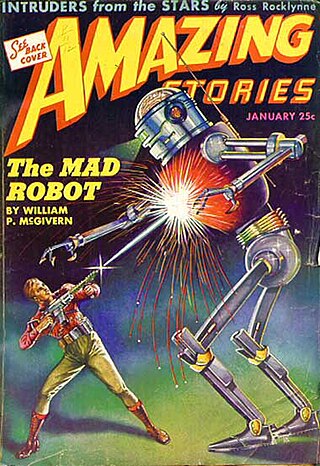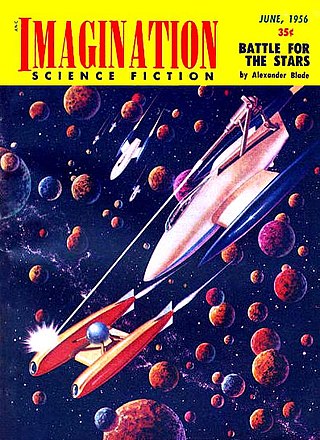
Ray Douglas Bradbury was an American author and screenwriter. One of the most celebrated 20th-century American writers, he worked in a variety of genres, including fantasy, science fiction, horror, mystery, and realistic fiction.
Starburst most often refers to:

Strange and exotic weapons are a recurring feature in science fiction. In some cases, weapons first introduced in science fiction have been made a reality; other science-fiction weapons remain purely fictional, and are often beyond the realms of known physical possibility.
Dragon Fire may refer to:
Jumping is a form of locomotion or movement in which an organism or non-living mechanical system propels itself through the air along a ballistic trajectory.
A chrysalis is the pupa stage of a butterfly.
POV most commonly refers to:
Doomsday Machine may refer to:

Blackfish Publishing was a magazine publishing company based in Bath, UK. Its first title was Death Ray, a science fiction and fantasy title.
Death Ray was a British magazine devoted to science fiction and fantasy in all its forms, especially media-related topics and novels. It was published every two months, with the first issue going on sale in May 2007. Typical issues were 132 pages, perfect bound, on glossy paper.
A raygun is a weapon, delivering to a target a beam of destructive particles or radiant energy, and generally featuring very slow diverging of the (destructive-energy density of the beam, due to any lateral spreading as distance from the weapon increases.

The death ray or death beam was a theoretical particle beam or electromagnetic weapon first theorized around the 1920s and 1930s. Around that time, notable inventors such as Guglielmo Marconi, Nikola Tesla, Harry Grindell Matthews, Edwin R. Scott, Erich Graichen and others claimed to have invented it independently. In 1957, the National Inventors Council was still issuing lists of needed military inventions that included a death ray.

A raygun is a science-fiction directed-energy weapon that releases energy, usually with destructive effect. They have various alternate names: ray gun, death ray, beam gun, blaster, laser gun, laser pistol, phaser, zap gun, etc. In most stories, when activated, a raygun emits a ray, typically visible, usually lethal if it hits a human target, often destructive if it hits mechanical objects, with properties and other effects unspecified or varying.

The War of the Worlds is a 1953 American science fiction film directed by Byron Haskin, produced by George Pal, and starring Gene Barry and Ann Robinson. It is the first of several feature film adaptations of H. G. Wells' 1898 novel of the same name. The setting is changed from Victorian era England to 1953 Southern California.
In science fiction, the Heat-Ray is a weapon used by the Martians in H. G. Wells' The War of the Worlds and its offshoots.

Space opera is a subgenre of science fiction that emphasizes space warfare, with use of melodramatic, risk-taking space adventures, relationships, and chivalric romance. Set mainly or entirely in outer space, it features technological and social advancements in faster-than-light travel, futuristic weapons, and sophisticated technology, on a backdrop of galactic empires and interstellar wars with fictional aliens, often in fictional galaxies. The term does not refer to opera music, but instead originally referred to the melodrama, scope, and formulaicness of operas, much as used in "horse opera", a 1930s phrase for a clichéd and formulaic Western film, and "soap opera", a melodramatic television series. Space operas emerged in the 1930s and continue to be produced in literature, film, comics, television, video games and board games.
Austin James Small was an English writer of thriller, detective, science fiction, adventure, romance, and western novels and short stories. Most of Small's titles appeared in Britain under the pen name Seamark, while his American publisher preferred using the name Austin J. Small. Several film plots were based on his stories.






